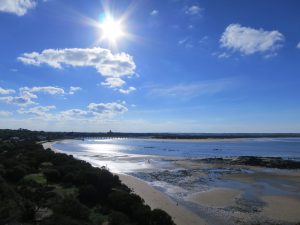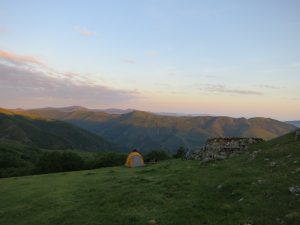Everyone’s idea of a good holiday is different but whatever your style, there are many ways to put more fizz into your trip while spending less, being in the moment more and having a better impact for the local economy and environment of where you visit.
Given how much we spend on holidays as a nation (and the environmental footprint it leaves behind), it’s worth pausing to think about ways to travel on less or how to enjoy a travel experience when long distance travel isn’t always an option [1].
Based on the book How to Travel the World on $50 a Day by Matt Kepnes, our benchmark is $60AUD per person give or take [2]. The slower ways of travel mentioned below can make “expensive” places much more reasonable:
Substitution
- Sometimes, the desire to escape can be easily had without actually having to go on holiday.
- Given that over two thirds of Australians live in major cities, it’s often easy to find the chance to do something different if you want a break from your routine.
- Possible substitutions could include a staycation (see below) or doing something in your area that you don’t normally do (like seeing an opera or cooking dinner on the beach at sunset).
Local/regional adventures

- Despite having travelled through 30 countries, some of our most interesting trips have been within a few hours of Melbourne and most can be adapted to a car free lifestyle.
- Many parts of Australia cater to low cost/high adventure travel like hiking and bike touring.
- Other ways to spice up local travel include doing a house swap (formally or informally with friends/family), learning some farming skills via WWOOFing, or using a hospitality exchange program like CouchSurfing.
Quality, not quantity
- Ok, we get it that some of us (ourselves included) occasionally have a burning desire to go and see a country, continent or state that is a long way from home.
- In this case, it is better to appreciate what you see rather than trying to tick off every country or place on a checklist. Take the time to explore an area.
- If you really want to explore multiple countries or a continent, perhaps consider giving the flight you took the respect it deserves, save some money and take out a couple of months or more to really make the most of your trip there.

Some trip ideas:
- A winter staycation weekend with fine food, nice drinks, a heap of movies from the library and long brunches in a cosy lounge room (bring the dining table in), $30 per person.
- Start a walk from a train station for a two day hike passing through some forest then ambling down a country road, camping somewhere in the middle, chatting to any locals you meet, $50 per person.
- Swap houses with a friend for a week. We did this by exchanging our bay side location with a friend’s nice country property. Even though we needed to hire a small car to get there and get around, the whole trip cost us just $400 for the week.
- Take a bike tour for four weeks through Tasmania (or another beautiful region) with your camping gear on the back, sometimes staying with a Warmshowers host, cooking delicious food out in the open and savouring some beautiful scenic roads, beaches and rivers. $1500 per person.
- So you want to see Thailand? Spend 6 weeks there enjoying local street food, using public transport, staying in budget but tidy bungalows and going to some of lesser known places in the north. $4000 for two including flights.
Slow travel can be tweaked to suit everyone’s level of adventure or comfort. It can be anything from a comfortable stay at home (yours or someone else’s) through to creating your own adventure on foot or by bike. Either way, it’s cheaper, has a lower impact and you get to have real connections with the place you’re staying at.
Further Reading:
[1] In 2018, a collaborative study found that tourism contributed to 8% of total global greenhouse gas emissions, higher than previously thought. The research done is very useful, though for the record, we would rather see genuine suggestions to lower travel emissions than just paying to try and “offset” them as suggested in this article:
[2] The premise of How to Travel the World on $50 a Day is that when travelling across a mix of expensive and less expensive countries, a traveller can have a enjoyable trip on an average of $50USD a day. As Australians, we interpret this as $60AUD a day even though the exchange rate can vary.
All of the trips we did in Europe while living there and in Australia where possible to do on $60AUD per person including the occassional accommodation, eating out and long distance train or ferry travel. So it is possible to travel in expensive countries like Australia on $50USD per person a day if you use the above tips.